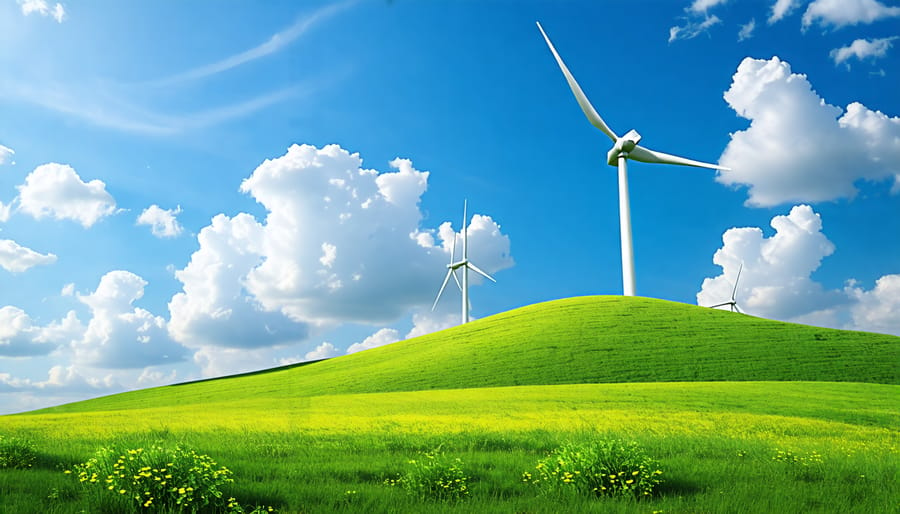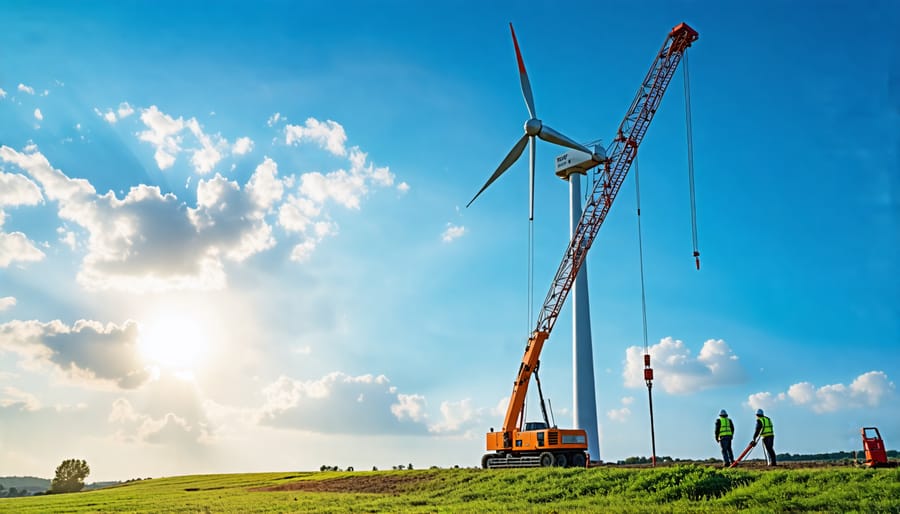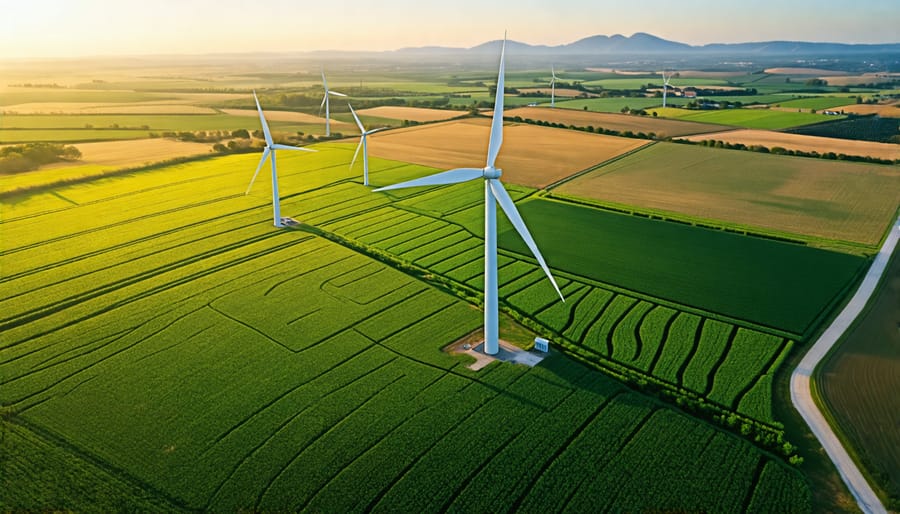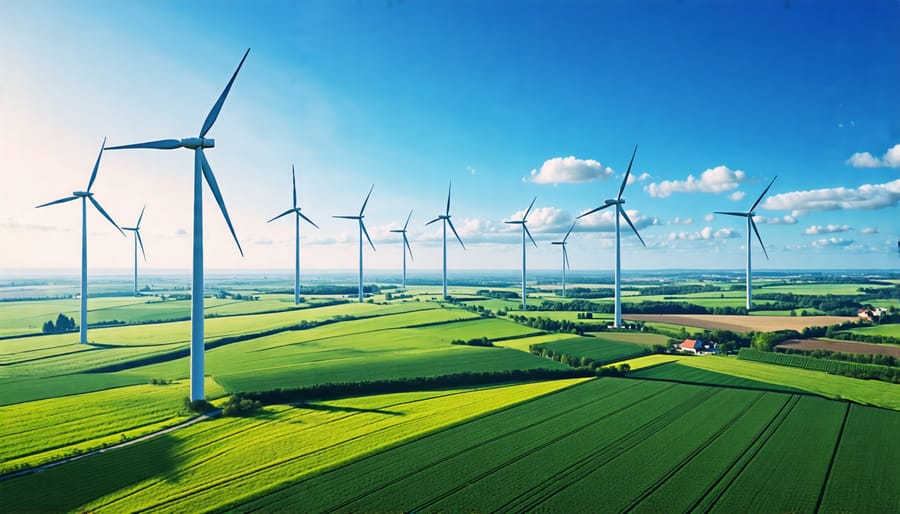Harness the power of the wind for a cleaner, more sustainable future. Wind energy offers three key benefits that make it an increasingly attractive alternative to fossil fuels:
1. Wind is an infinite, renewable resource that will never run out, unlike oil, coal and natural gas. By transitioning to wind power, we can reduce our reliance on finite, polluting energy sources and ensure a reliable supply of clean electricity for generations to come.
2. Generating electricity from wind creates no direct greenhouse gas emissions or air pollutants. Widespread adoption of wind energy is critical for combating climate change, improving air quality, and protecting public health. Every megawatt-hour of wind power avoids an average of 1,200 pounds of carbon dioxide emissions.
3. Wind energy is cost-competitive with conventional energy sources and even cheaper in many cases, especially when accounting for tax incentives and the societal costs of pollution. The “fuel” for wind power is free, providing long-term price stability and insulation from the volatility of fossil fuel markets. Wind farms also generate local economic benefits through tax revenue, lease payments to landowners, and job creation in construction, manufacturing, and operations.
The urgent environmental and economic imperatives for clean energy solutions have never been clearer. With its limitless supply, minimal environmental impact, and attractive economics, wind power will play an indispensable role in building a sustainable energy future. The time to invest in this transformative technology is now.
Clean and Renewable

Combating Climate Change
Wind power plays a crucial role in mitigating climate change by reducing greenhouse gas emissions from fossil fuel-based electricity generation. As a clean, renewable energy source, wind turbines generate electricity without releasing carbon dioxide, sulfur dioxide, or nitrogen oxides into the atmosphere. According to the American Wind Energy Association, the wind energy capacity installed in the United States by the end of 2020 has the potential to avoid 198 million metric tons of carbon dioxide emissions annually – equivalent to taking 42 million cars off the road.
Moreover, every megawatt-hour of wind energy produced reduces the need for fossil fuel combustion, further decreasing greenhouse gas emissions. As global efforts to combat climate change intensify, wind power is expected to play an increasingly significant role in decarbonizing the electricity sector. By investing in wind energy infrastructure and technology, nations can make substantial progress towards meeting their emissions reduction targets under the Paris Agreement, while simultaneously improving air quality and public health. The expansion of wind power, alongside other renewable energy sources, is a critical step in the transition to a low-carbon, sustainable future.
Preserving Natural Resources
Wind energy preserves our planet’s precious natural resources in two key ways. First, it conserves water, a vital and increasingly scarce resource. While fossil fuel and nuclear power plants consume vast amounts of water for cooling, wind turbines require virtually no water to operate. In fact, wind power saves billions of gallons of water annually in the United States alone. Second, wind energy eliminates the need to deplete finite fuel resources like coal, oil, and natural gas. These non-renewable resources take millions of years to form and are being rapidly depleted by human consumption. In contrast, wind is an inexhaustible resource that will never run out. By harnessing the power of the wind, we can generate electricity without diminishing the Earth’s limited supply of fossil fuels. This not only helps to conserve these resources for future generations but also reduces our dependence on environmentally damaging extraction methods like fracking and strip mining. The conservation of water and finite fuel resources through wind energy is a crucial step towards a more sustainable future for our planet.
Economic Advantages

Boosting Local Economies
Wind energy projects provide a powerful economic boost to local communities, creating jobs, generating income for landowners, and stimulating sustainable development. According to the American Wind Energy Association, the wind industry currently supports over 120,000 jobs across all 50 states, including manufacturing, construction, operation, and maintenance positions. These jobs often provide competitive salaries and benefits, attracting skilled workers and revitalizing local economies.
In addition to job creation, wind projects generate significant lease payments for landowners who host turbines on their properties. Farmers and ranchers can earn steady income from these leases while continuing to use their land for agriculture or grazing, providing a valuable supplementary revenue stream. This financial support helps maintain the viability of family farms and ranches, preserving rural traditions and way of life.
The economic benefits of wind energy extend beyond direct employment and lease payments. Wind projects stimulate local economies by increasing the tax base, providing funds for schools, infrastructure, and community services. Developers often invest in road improvements, grid upgrades, and other infrastructure enhancements that benefit entire communities. Furthermore, the influx of workers during construction and the ongoing presence of maintenance crews boost local businesses, such as restaurants, hotels, and retail stores.
The ripple effect of wind energy development can be transformative for rural communities, creating opportunities for diversification and sustainable growth. By embracing wind power, these communities not only contribute to the transition to clean energy but also secure their economic future, ensuring a more prosperous and resilient tomorrow.
Stabilizing Energy Costs
Wind energy provides a reliable and affordable source of electricity that can help stabilize energy costs for consumers and businesses alike. Unlike fossil fuels, which are subject to market volatility and price fluctuations, wind power offers affordable, stable-priced electricity. Once a wind farm is constructed, the cost of generating electricity remains relatively constant over the life of the project, typically 20-30 years.
This price stability acts as a hedge against the unpredictable nature of fossil fuel prices, which can be influenced by geopolitical events, supply chain disruptions, and other factors beyond our control. When natural gas or oil prices spike, it directly impacts the cost of electricity generated from these sources. In contrast, wind energy is not subject to these price shocks, providing a more secure and predictable energy supply.
Moreover, as technology advances and wind turbines become more efficient, the cost of wind-generated electricity continues to decline. According to recent studies, wind energy is now one of the most cost-competitive sources of new electricity generation, even without considering government incentives or subsidies. This trend is expected to continue, making wind power an increasingly attractive option for meeting our energy needs while keeping costs in check.
By incorporating more wind energy into the grid, we can create a more diverse and resilient energy mix that is less vulnerable to price volatility. This benefits not only individual consumers but also businesses and industries that rely on stable energy costs to remain competitive in the global market.
Efficient Land Use
Wind turbines are a shining example of efficient land use in the renewable energy sector. Unlike traditional power plants that require vast tracts of dedicated land, wind farms can coexist harmoniously with other land uses. The towering turbines, with their sleek blades gracefully spinning in the breeze, occupy only a small footprint on the ground. This leaves ample space for activities such as agriculture, ranching, and even recreation to continue unimpeded.
One of the most remarkable aspects of wind energy is its compatibility with agriculture. Farmers can continue to cultivate their crops or graze their livestock right up to the base of the turbines. The spacing between turbines allows for easy access by farm machinery, ensuring that agricultural operations remain unhindered. In fact, the additional income generated from leasing land to wind energy companies can provide a valuable financial boost to farmers, helping to diversify their revenue streams and enhance the long-term viability of their farms.
Moreover, the infrastructure associated with wind farms, such as access roads and transmission lines, can actually benefit agricultural communities. Improved road networks make it easier for farmers to transport their goods to market, while the presence of wind turbines can attract tourists interested in sustainable energy, potentially creating new economic opportunities in rural areas.
Ranching, another vital land use in many regions, also finds a perfect partner in wind energy. Cattle and other livestock can graze freely among the turbines, taking advantage of the ample space between them. The towering structures provide welcome shade and shelter for the animals during hot summer months, while the gentle humming of the blades creates a soothing ambiance across the landscape.
By embracing wind energy, we can maximize the productivity of our land, generating clean electricity while preserving the essential activities that sustain our communities. It’s a win-win situation that demonstrates the ingenuity and adaptability of the human spirit in the face of the pressing need for sustainable solutions. As we continue to harness the power of the wind, we can look forward to a future where energy production and thriving landscapes go hand in hand, ensuring a greener and more prosperous world for generations to come.

Conclusion
In conclusion, wind energy offers a compelling solution to our growing energy demands while addressing critical environmental, economic, and land use challenges. By harnessing the clean, renewable power of the wind, we can significantly reduce greenhouse gas emissions, combat climate change, and improve air quality. Moreover, wind energy creates jobs, stimulates local economies, and offers a cost-competitive alternative to fossil fuels. Its efficient land use also allows for the coexistence of energy production with agriculture and other land uses. As we face the urgent need to transition to a sustainable future, transitioning to wind energy is not just an option but a necessity. By supporting the development of wind power projects, investing in research and innovation, and advocating for policies that promote renewable energy, we can all play a role in building a cleaner, more resilient world for generations to come. The benefits of wind energy are clear – now is the time to embrace this powerful force of nature and harness the winds of change for a brighter, more sustainable future.





